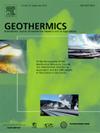Circulation process of geothermal fluids and potential assessment of geothermal resources in the Songwe half-graben and Kiejo-Mbaka prospects in southwestern Tanzania: Insight from hydrochemistry and stable isotopes
IF 3.5
2区 工程技术
Q3 ENERGY & FUELS
引用次数: 0
Abstract
The Songwe and Kiejo-Mbaka geothermal prospects in Tanzania's East African Rift System are anticipated to be harnessed for geothermal power generation by 2030. This study examines the geothermal fluids' origin, evolution, and natural geothermal potential through geochemical analyses of stable isotopes, major ions, trace solutes, and fluid–mineral equilibria. Analysis samples were taken from hot, warm and cold springs, rivers, and rainwater from the prospects. The predominant Na and K in the samples suggest advanced chemical reactions composed primarily of ion exchange and calcite dissolution in the geothermal system. Four reservoirs, Songwe-Rambo and Kaguri (Songwe) and Ilwalilo and Kilambo (Kiejo-Mbaka), are identified as fluid upflow zones of geothermal systems. Mineral equilibria modeling reveals two key features: saturation with carbonate minerals like aragonite, dolomite, and calcite, linked to travertine development near discharge zones, and silica saturation, primarily quartz and chalcedony, across varying temperatures, suggesting potential silica deposits. Estimated reservoir temperatures range from 90 to 135 °C (Songwe) to 100–145 °C (Kiejo-Mbaka), based on geothermometry methods. Given flow rates of 0.05–10 L/s and temperature differences of 20.8–145 °C, the geothermal power potential is assessed at 4 MWth for Songwe and 5 MWth for Kiejo-Mbaka. The primary source of geothermal fluids is meteoric water, recharged at about 2100 m above sea level, which infiltrates to an average depth of ca. 2000 m, driven by heat sources, before re-emerging at the surface. A conceptual model of the geothermal system over these prospects is developed, enhancing the groundwork for evaluating geothermal resources and planning future exploratory drilling.

坦桑尼亚西南部松圭半地堑地热流体循环过程与地热资源潜力评价及Kiejo-Mbaka远景:来自水化学和稳定同位素的启示
坦桑尼亚东非裂谷系统的Songwe和Kiejo-Mbaka地热勘探区预计到2030年将用于地热发电。本文通过稳定同位素、主要离子、微量溶质、流矿平衡等地球化学分析,探讨了地热流体的成因、演化和天然地热潜力。分析样本取自热泉、温泉和冷泉、河流和来自前景的雨水。样品中主要的Na和K表明地热系统中主要由离子交换和方解石溶解组成的高级化学反应。Songwe- rambo和Kaguri (Songwe)和Ilwalilo和Kilambo (kijo - mbaka)四个储层被确定为地热系统的流体上行带。矿物平衡模型揭示了两个关键特征:碳酸盐矿物的饱和度,如文石、白云石和方解石,与排泄带附近的石灰华发育有关;二氧化硅饱和度,主要是石英和玉软石,在不同的温度下,表明潜在的二氧化硅矿床。根据地热测量方法,估计储层温度范围为90 ~ 135℃(Songwe)至100 ~ 145℃(Kiejo-Mbaka)。在流量为0.05 ~ 10 L/s、温差为20.8 ~ 145℃的条件下,Songwe和Kiejo-Mbaka的地热发电潜力分别为4 MWth和5 MWth。地热流体的主要来源是大气水,在海拔2100米左右补给,在热源的驱动下渗入到平均约2000米的深度,然后在地表重新出现。在这些远景区建立了地热系统的概念模型,为评价地热资源和规划未来的勘探钻探奠定了基础。
本文章由计算机程序翻译,如有差异,请以英文原文为准。
求助全文
约1分钟内获得全文
求助全文
来源期刊

Geothermics
工程技术-地球科学综合
CiteScore
7.70
自引率
15.40%
发文量
237
审稿时长
4.5 months
期刊介绍:
Geothermics is an international journal devoted to the research and development of geothermal energy. The International Board of Editors of Geothermics, which comprises specialists in the various aspects of geothermal resources, exploration and development, guarantees the balanced, comprehensive view of scientific and technological developments in this promising energy field.
It promulgates the state of the art and science of geothermal energy, its exploration and exploitation through a regular exchange of information from all parts of the world. The journal publishes articles dealing with the theory, exploration techniques and all aspects of the utilization of geothermal resources. Geothermics serves as the scientific house, or exchange medium, through which the growing community of geothermal specialists can provide and receive information.
 求助内容:
求助内容: 应助结果提醒方式:
应助结果提醒方式:


